Forgotten Florida: Stars Hall of Fame
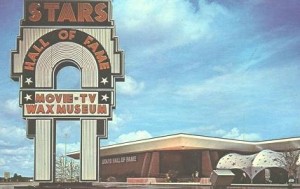 Special Note: The Stars Hall of Fame wax museum was one of my favorite Florida attractions during it’s slightly less than a decade of operation. Very little exists to document this forgotten attraction so this special two part article will serve as both an informative document and a pictorial recreation.
Special Note: The Stars Hall of Fame wax museum was one of my favorite Florida attractions during it’s slightly less than a decade of operation. Very little exists to document this forgotten attraction so this special two part article will serve as both an informative document and a pictorial recreation.
Orlando, Florida was in a major upheaval in the early 1970’s. Walt Disney World had opened in 1971 and brought a flood of renewed tourism with it in its wake. In answer to the need for additional attractions to keep the tourist dollars in the state, both the Sea World and Circus World theme parks opened just a few years later. The Six Flags Theme Park Corporation had considered opening a competing park in Florida about an hour north of Disney but had abandoned the idea in favor of diversifying into smaller attractions. One of their early acquisitions was the Movieland Wax Museum in Buena Park, California which was continuing to draw sizable crowds. A logical extension seemed to be the creation of a similar museum in Orlando using Movieland as a template.
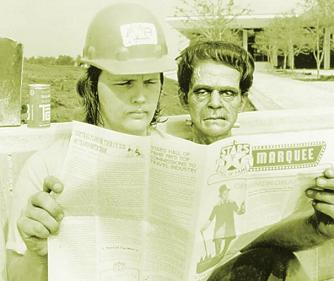
Even before Stars Hall of Fame opened wax figures were appearing in Florida.
On May 10, 1975, the doors of Stars Hall of Fame opened to movie fans and tourists looking for an indoor air conditioned alternative to Walt Disney World. The museum was located at number 6825 on the rather aptly named Starway Drive in Orlando. It was close to Sea World at the intersection of I-4 and the Beeline Expressway in the area that is now referred to as International Drive. In 1975, this land was largely undeveloped rather than the thriving Mecca of commerce it is today. In a short period of time, other smaller attractions like the Wizard’s Mystery Fun House and Wet N’ Wild would pop up to keep it company but initially the wax museum appeared to be in the middle of nowhere.
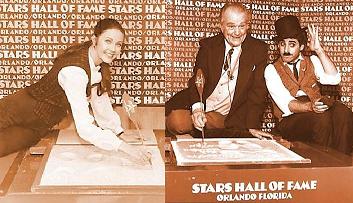
Linda "Wonder Woman" Carter and comedian Red Skelton were just two of the real stars who visited the wax museum.
The entrance way to Stars Hall of Fame was called the Plaza of the Stars and attempted to recreate the feel of Grauman’s Chinese Theater in Hollywood with celebrity hand and footprints preserved in cement. Most of these were reproductions but the museum did host a number of famous guests over the years and many were given dedication ceremonies where the impressions were taken. Once inside the building, visitors were treated to a multi-media show called The Hollywood Experience in Electrovision. This was a multi-screen presentation that gave a brief overview of the history of motion pictures and the entertainment industry in general to set the mood for the tour they were about to take. Upon leaving the theater, visitors passed through the Time Tunnel, a journey “through the stars” that surrounded them with one hundred and thirty illuminated portraits of celebrities. This was the bridge between the real world and the reel world they were about to enter!
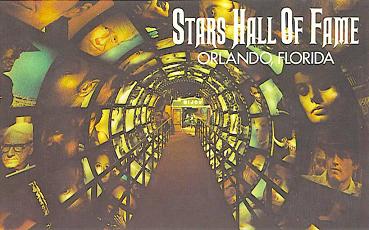
The Time Tunnel - movie star style.
The wax museum portion of the attraction contained approximately two hundred figures that were displayed in over one hundred different sets. They were loosely divided into areas that each honored a different era or genre of entertainment. The initial segment, logically enough, was a tribute to the silent films and early talkies. Most of the scenes were completely static but some did feature music or audio clips from the films they represented and a few even had limited motion. There were no barriers separating the guests from the scene displays but there were warning alarms that sounded if anyone got to close to the merchandise.
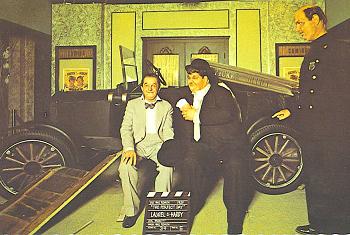
Comedians Stan Laurel and Oliver Hardy, along with Officer Edgar Kennedy, greeted visitors as they entered the museum.
The first section was largely dedicated to comedic actors like Charlie Chaplin, Buster Keaton, and Laurel and Hardy but it also held displays for Rudolph Valentino and William S. Hart. After this came the Golden Age of movies and more recognizable faces like W.C. Fields, Mae West, Fred Astaire, and Ginger Rogers. Close by, a comedic trio of Marx Brothers was posed around a piano in a scene from one of their most famous films, Animal Crackers. One of the most elaborate sets in the entire museum was from the Shirley Temple film Bright Eyes depicting the fantasy sequence in which she sang The Good Ship Lollipop. This had moving toys, an audio loop of the song, and even a revolving figure of Shirley atop an impressive recreation of the famous vessel. This area led into a display containing all of the major characters from The Wizard of Oz and a special exhibit for the Our Gang comedies which included many of their most famous members.
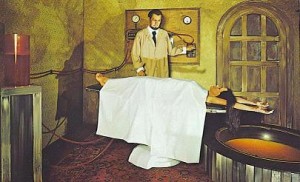
Vincent Price in House of Wax.
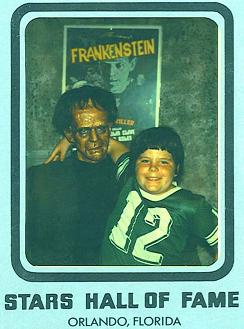
ED Tucker's nine year old alter ego meets Frankenstein in one of the museum's photo op areas.
The next section of the museum was a particular favorite of mine as it was dedicated to horror films. It primarily paid tribute to the pioneers of the genre like Boris Karloff in Frankenstein and Bela Lugosi in Dracula. There was also a display for the Lon Chaney, Sr. version of The Hunchback of Notre Dame near one for his son in his most famous role as the Wolfman. A rather obvious but still appreciated selection was Vincent Price in House of Wax! One of the most impressive scenes in this area featured Frederick March in the 1932 version of Dr. Jekyll and Mr. Hyde for which he received an Oscar. As visitors stared at the stoic face of March, he suddenly transformed (thanks to some lights and mirrors) into the hideous Hyde. While not really a horror film but still a spectacular feat of makeup, a group of simians – two familiar chimpanzees and an orangutan, were shown standing guard behind cell bars in a scene from Planet of the Apes.
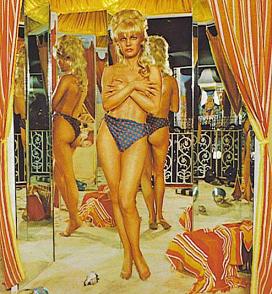
A modest Bridgette Bardot in And God Created Woman.
Following the creature corner was the film classics area that was far more cheerful even if some of the films represented were very serious. Clark Gable and Vivian Leigh posed on a scaled down reproduction of a Civil War era southern plantation from Gone with the Wind, complete with a running stream and a running audio commentary. Also included in this section were African Queen with Humphrey Bogart, The King and I, and a chilling winter scene from Dr. Zhivago with Omar Sharif and Rod Steiger. This lead to the glamour stars area which featured tributes to some of the lovely ladies of the silver screen like Marilyn Monroe, Elizabeth Taylor, and Bridgette Bardot posing topless but tastefully obscured in a scene from her most famous film, And God Created Woman. A slightly more unusual choice was Nancy Sinatra who was depicted seated atop a chrome motorcycle from Roger Corman’s Wild Angels and looking like she was ready to roar out of the museum at any moment.
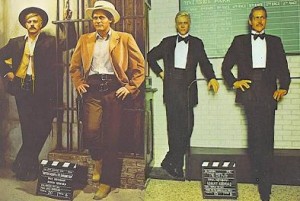 Segregated from the classics were the more action oriented films in what the Stars Hall of Fame termed the epic section. Most of the displays here were larger and more elaborate than those found in the rest of the museum. The climatic chariot race from the film Ben Hur was faithfully reproduced, horses and all. Nearby was Kirk Douglass fighting for his life in the gladiator scene from Spartacus. Other exhibits in this area included Marlon Brando as The Godfather and George C. Scott as Patton. One especially creative display had Cliff Robertson as future President John F. Kennedy saving crew members of the sinking PT-109. It was situated in a tank of water with the nose of the boat sticking out of it. The scene everyone remembers from this section though was of Paul Newman and Robert Redford. A revolving stage depicted them on one side as Butch Cassidy and the Sundance Kid in the movie of the same name and as their con artist characters Henry Gondoroff and Johnny Hooker from The Sting on the other.
Segregated from the classics were the more action oriented films in what the Stars Hall of Fame termed the epic section. Most of the displays here were larger and more elaborate than those found in the rest of the museum. The climatic chariot race from the film Ben Hur was faithfully reproduced, horses and all. Nearby was Kirk Douglass fighting for his life in the gladiator scene from Spartacus. Other exhibits in this area included Marlon Brando as The Godfather and George C. Scott as Patton. One especially creative display had Cliff Robertson as future President John F. Kennedy saving crew members of the sinking PT-109. It was situated in a tank of water with the nose of the boat sticking out of it. The scene everyone remembers from this section though was of Paul Newman and Robert Redford. A revolving stage depicted them on one side as Butch Cassidy and the Sundance Kid in the movie of the same name and as their con artist characters Henry Gondoroff and Johnny Hooker from The Sting on the other.
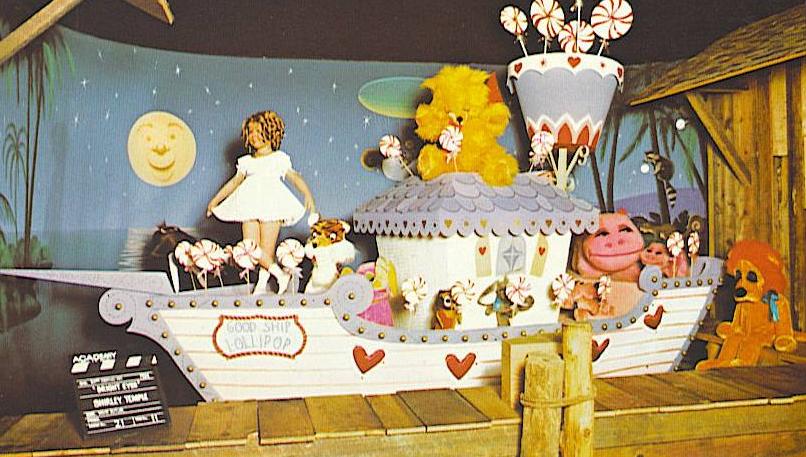
Shirley Temple performing The Good Ship Lollipop with moving stuffed animals was one of Stars Hall of Fame's most elaborate exhibits.
Coming in Part 2: The stars of television and music, attempts at updates, and ED Tucker meets The Beatles! (well sort of)
